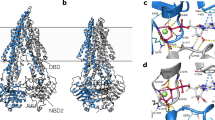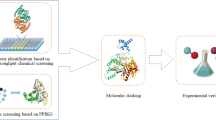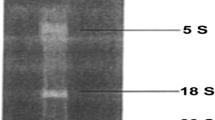Abstract
The gene encoding the multidrug resistance P-glycoprotein (P-gp) is duplicated in rodent species and the functional basis for this remains unresolved. Despite a high sequence similarity, the mouse P-gp1a and P-gp1b isoforms show distinct patterns of tissue distribution which suggest a specific role of the P-gp1b isoform in steroid transport. In the present study possible biochemical differences between the isoforms were directly investigated at the level of drug interaction. There was no detectable difference in the affinity or binding capacity of the two isoforms towards [3H]vinblastine at equilibrium. Similarly, the rate at which [3H]vinblastine associates with P-gp was indistinguishable between the two isoforms. Some modest differences were observed in the relative abilities of the multidrug-resistant (MDR) reversing agents CP100-356, nicardipine and verapamil to displace equilibrium [3H]vinblastine binding to P-gp1a and P-gp1b. The steroid hormone progesterone displayed a low affinity (Ki = 1.2 ± 0.2 μM for P-gp1a and 3.5 ± 0.5 μM for P-gp1b), suggesting an unlikely role as a physiological substrate. Thus the mouse isoforms do not appear to exhibit functional differences at the level of initial substrate interaction with protein.
Similar content being viewed by others
Article PDF
Change history
16 November 2011
This paper was modified 12 months after initial publication to switch to Creative Commons licence terms, as noted at publication
References
Altuvia, S, Stein, WD, Goldenberg, S, Kane, SE, Pastan, I & Gottesman, MM (1993) Targeted disruption of the mouse mdr1b gene reveals that steroid hormones enhance mdr gene expression. J Biol Chem 268: 27127–27132.
Arceci, RJ, Croop, JM, Horwitz, SB & Housman, D (1988) The gene encoding multidrug resistance is induced and expressed at high levels during pregnancy in the secretory epithelium of the uterus. Proc Natl Acad Sci USA 85: 4350–4354.
Ayesh, S, Shao, Y-M & Stein, WD (1996) Co-operative, competitive and non-competitive interactions between modulators of P-glycoprotein. Biochim Biophys Acta 1316: 8–18.
Barnes, KM, Dickstein, B, Cutler, GB, Fojo, T & Bates, SE (1996) Steroid transport, accumulation and antagonism of P-glycoprotein in multidrug resistant cells. Biochemistry 35: 4820–4827.
Burgisser, E (1984). Radioligand-receptor binding studies; what’s wrong with the Scatchard analysis? Trends Biochem Sci 142–144
Cheng, Y & Prusoff, WH (1973) Relationship between the inhibition constant (Ki) and the concentration of inhibitor which causes 50% inhibition (IC50) of an enzymic reaction. Biochem Pharmacol 22: 3099–3108.
Croop, JM, Raymond, M, Haber, D, Devault, A, Arceci, RJ, Gros, P & Housman, DE (1989) The three mouse multidrug resistance (mdr) genes are expressed in a tissue-specific manner in normal mouse tissues. Mol Cell Biol 9: 1346–1350.
De Lean, A, Munson, PJ & Rodbard, D (1978) Simultaneous analysis of families of sigmoidal curves: applications to bioassay, radioligand assay and physiological dose response curves. J Physiol 235: E97–E102.
Devault, A & Gros, P (1990) Two members of the mouse mdr gene family confer multidrug resistance with overlapping but distinct drug specificities. Mol Cell Biol 10: 1652–1663.
Ferry, DR, Russell, MA & Cullen, MH (1992) P-glycoprotein possesses a 1,4-dihydropyridine selective drug acceptor site which is allosterically coupled to a vinca alkaloid selective binding site. Biochem Biophys Res Commun 188: 440–445.
Ferry, DR, Malkhandi, JP, Russell, MA & Kerr, DJ (1995) Allosteric regulation of [3H]vinblastine binding to P-glycoprotein of MCF-7 Adr cells by dexniguldipine. Biochem Pharmacol 49: 1851–1861.
Garrigos, M, Mir, LM & Orlowski, S (1997) Competitive and non-competitive inhibition of the multidrug resistance-associated p-glycoprotein atpase: further experimental evidence for a multisite model. Eur J Biochem 244: 644–673.
Georges, E, Bradley, G, Gariepy, J & Ling, V (1990) Detection of P-glycoprotein isoforms by gene specific monoclonal antibodies. Proc Natl Acad Sci USA 87: 152–156.
Gill, DR, Hyde, SC, Higgins, CF, Valverde, MA, Mintenig, GM & Sepulveda, FV (1992) Separation of drug transport and chloride channel functions of the human multidrug resistance P-glycoprotein. Cell 71: 23–32.
Gottesman, MM & Pastan, I (1988) The multi-drug transporter: a double edged sword. J Biol Chem 263: 12163–12166.
Gros, P, Croop, J & Housman, D (1986) Mammalian multidrug resistance gene: complete cDNA sequence indicates strong homology to bacterial transport proteins. Cell 47: 371–380.
Hardy, SP, Goodfellow, HR, Valverde, MA, Gill, DR, Sepulveda, FV & Higgins, CF (1995) Protein kinase C-mediated phosphorylation of the human multidrug resistance P-glycoprotein regulates cell volume-activated chloride channels. EMBO J 14: 68–75.
Kajiji, S, Talbot, F, Grizzuti, K, Van Dyke-Phillips, V, Agresti, M, Safa, A & Gros, P (1993) Functional analysis of P-glycoprotein mutants identifies predicted transmembrane domain 11 as a putative drug binding site. Biochemistry 32: 4185–4194.
Kajiji, S, Dreslin, JA, Grizzuti, K & Gros, P (1994) Structurally distinct MDR modulators show specific patterns of reversal against P-glycoproteins bearing unique mutations at serine939/941. Biochemistry 33: 5041–5048.
Kenakin, T (1997). In Pharmacologic Analysis of Drug-Receptor Interaction pp. 198–241. Lippincott-Raven, Philadelphia
Lever, JE (1977) Active amino-acid transport in plasma membrane vesicles from Simian virus 40-transformed mouse fibroblasts. Characteristics of electrochemical Na+ gradient stimulated uptake. J Biol Chem 252: 1990–1997.
Malkhandi, J, Ferry, DR, Boer, R, Gekeler, V, Ise, W & Kerr, DJ (1994) Dexniguldipine-HCl is a potent allosteric inhibitor [3H]vinblastine binding to P-glycoprotein of CCRF ADR5000 cells. Eur J Pharmacol 288: 105–114.
Martin, C, Berridge, G, Higgins, CF & Callaghan, R (1997) The multidrug resistance reversal agent SR33557 and modulation of vinca alkaloid binding to P-glycoprotein by an allosteric interaction. British J Pharmacol 121: in press
Orlowski, S, Mir, LM, Belehradek, JR & Garrigos, M (1996) Effects of steroids and verapamil on P-glycoprotein ATPase activity: progesterone, desoxycorticosterone, corticosterone and verapamil are mutually non-exclusive modulators. Biochem J 317: 515–522.
Piekarz, RL, Cohen, D & Horwitz, SB (1993) Progesterone regulates the murine multidrug resistance mdr1b gene. J Biol Chem 268: 7613–7616.
Schinkel, AH, Smit, JJ, van Tellingen, O, Beijnen, JH, Wagenaar, E, van Deemter, L, Mol, CAAM, van der Valk, MA, Robanus-Maandag, EC, te Riele, HPJ, Berns, JM & Borst, P (1994) Disruption of the mouse mdr1a P-glycoprotein gene leads to a deficiency in the blood–brain barrier and to increased sensitivity to drugs. Cell 77: 491–502.
Spoelstra, EC, Westerhoff, HV, Dekker, H & Lankelma, J (1992) Kinetics of doxorubicin transport by P-glycoprotein of intact cancer cells. Eur J Biochem 207: 567–579.
Tang-Wai, DF, Kajiji, S, DiCapua, F, de Graaf, D, Roninson, IB & Gros, P (1995) Human (MDR1) and mouse (mdr1, mdr3) P-glycoproteins can be distinguished by their respective drug resistance profiles and sensitivity to modulators. Biochemistry 34: 32–39.
Towbin, H, Staehlin, T & Gordon, J (1979) Electrophoretic transfer of proteins from polyacrylamide gels to nitrocellulose sheets: procedure and some applications. Proc Natl Acad Sci USA 76: 4350–4354.
Trezise, AEO, Romano, PR, Gill, DR, Hyde, SC, Sepulveda, FV, Buchwald, M & Higgins, CF (1992) The multidrug resistance and cystic-fibrosis genes have complementary patterns of epithelial expression. EMBO J 11: 4291–4303.
Ueda, K, Okamura, N, Hirai, M, Tanigawara, Y, Saeki, T, Kioka, N, Komano, T & Hori, R (1992) Human P-glycoprotein transports cortisol, aldosterone, but not progesterone. J Biol Chem 267: 24248–24252.
Valverde, MA, Bond, TD, Hardy, SP, Taylor, JC, Higgins, CF, Altamirano, J & Alvarez-Leefmans, FJ (1996) The multidrug resistance P-glycoprotein modulates cell regulatory volume decrease. EMBO J 15: 4460–4468.
Yang, CP, Cohen, D, Greenberger, LM, Hsu, SI & Horwitz, SB (1990) Differential transport properties of two mdr gene products are distinguished by progesterone. J Biol Chem 265: 10282–10288.
Author information
Authors and Affiliations
Rights and permissions
From twelve months after its original publication, this work is licensed under the Creative Commons Attribution-NonCommercial-Share Alike 3.0 Unported License. To view a copy of this license, visit http://creativecommons.org/licenses/by-nc-sa/3.0/
About this article
Cite this article
Taylor, J., Ferry, D., Higgins, C. et al. The equilibrium and kinetic drug binding properties of the mouse P-gp1a and P-gp1b P-glycoproteins are similar. Br J Cancer 81, 783–789 (1999). https://doi.org/10.1038/sj.bjc.6690764
Received:
Revised:
Accepted:
Published:
Issue date:
DOI: https://doi.org/10.1038/sj.bjc.6690764
Keywords
This article is cited by
-
Multidrug transporter activity in lymphocytes
British Journal of Pharmacology (2004)
-
Stereoselective transport of hydrophilic quaternary drugs by human MDR1 and rat Mdr1b P‐glycoproteins
British Journal of Pharmacology (2002)



